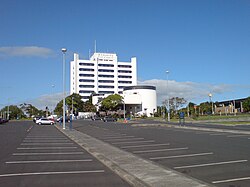|
Ōtara-Papatoetoe Local Board
The Ōtara-Papatoetoe Local Board is one of the 21 local boards of the Auckland Council. It is overseen by the Manukau ward councillors.[3] The local board area includes the suburbs of Ōtara, Papatoetoe, East Tāmaki, Puhinui and central Manukau.[3] DemographicsŌtara-Papatoetoe Local Board Area covers 37.11 km2 (14.33 sq mi)[1] and had an estimated population of 98,500 as of June 2024,[2] with a population density of 2,654 people per km2.
Ōtara-Papatoetoe had a population of 86,949 in the 2023 New Zealand census, an increase of 1,827 people (2.1%) since the 2018 census, and an increase of 11,286 people (14.9%) since the 2013 census. There were 24,561 dwellings. The median age was 31.1 years (compared with 38.1 years nationally). There were 20,448 people (23.5%) aged under 15 years, 21,177 (24.4%) aged 15 to 29, 37,569 (43.2%) aged 30 to 64, and 7,758 (8.9%) aged 65 or older.[5] Ethnicities were 14.6% European/Pākehā, 15.8% Māori, 48.7% Pasifika, 35.4% Asian, 1.0% Middle Eastern, Latin American and African New Zealanders, and 0.4% other. People may identify with more than one ethnicity.[5] Ōtara-Papatoetoe Local Board Area had a population of 85,122 at the 2018 New Zealand census. There were 20,412 households, comprising 42,900 males and 42,225 females, giving a sex ratio of 1.02 males per female. The percentage of people born overseas was 45.7, compared with 27.1% nationally. Although some people chose not to answer the census's question about religious affiliation, 18.2% had no religion, 48.5% were Christian, 1.6% had Māori religious beliefs, 12.0% were Hindu, 4.7% were Muslim, 2.0% were Buddhist and 7.8% had other religions. Of those at least 15 years old, 8,895 (13.8%) people had a bachelor's or higher degree, and 13,035 (20.2%) people had no formal qualifications. The median income was $25,900, compared with $31,800 nationally. 4,560 people (7.1%) earned over $70,000 compared to 17.2% nationally. The employment status of those at least 15 was that 32,469 (50.3%) people were employed full-time, 7,608 (11.8%) were part-time, and 3,735 (5.8%) were unemployed.[4] 2022–2025 termThe current board members, elected at the 2022 local body elections, are:[6]
2019–2022 termBoard members, elected at the 2019 local body elections, are:[7]
2016–2019 termThe board members who served from the 2016 local body elections to the 2019 election were:
References
|
||||||||||||||||||||||||||||||||||||||||||||||||||||||||||||||||||||||||||||||||||||||
Portal di Ensiklopedia Dunia

